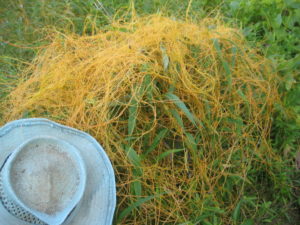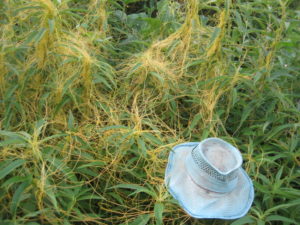Dodder, A Unique Plant
Occasionally, when out walking through a prairie or a weedy lot, you will find a patch of plants that look like it is snarled in a tangle of yellow or orange string. Closer examination reveals that it is actually living string, because when you break one, it bleeds. People with vivid imaginations or who have been watching too many horror movies suspect that it is an extraterrestrial life form and maybe it is going to entangle them also. I know several people who won’t touch it.
Actually, it is a plant called dodder, and Britton and Brown indicate about a hundred species scattered around the globe. Here in the US, we have several dozen species, many of them western and some imported from other continents. It is also called strangleweed (for obvious reasons), coral-vine (color), and love-vine (clinging).
The lack of green color means a lack of chlorophyll, and dodder survives by being parasitic on the green plants it envelopes in its web. Tiny aerial rootlets sprout from the tightly wrapped vines, which penetrate the host plant’s stem and suck out some of the plant’s juices.
If you examine a piece of the string under magnification, you will see little alternating scales, which are thought to be the atrophied former leaves of the green plant it evolved from. However, I do not know of any fossil record that confirms this. There are also little yellow or orange flowers, and they do make a capsule containing seed. The internet says that they smell like carrion and are pollenated by blow flies. Starting out as a sprouting seed in the soil, dodder quickly puts up a slender vine. But as it begins to entangle other plants, the roots and stem decay away. In the meantime, the upper dodder vine has punctured and is living off the green plant species it has enveloped, and it continues to grow into a more elaborate web of strings.

A maturing patch of orange dodder, now disconnected from the soil and living off its hosts.

A patch of yellow dodder, which has a different growth form than the orange.
I have not inquired whether it is a different species. The patch of orange dodder in the first photo has reappeared in that general area in most years for several decades, even though that area gets burned in most years. This makes me suspect that it is propagated by seed, which escapes the fire, perhaps just by being tiny and filtering down through the litter and into the upper soil.
In our area the host plants are the tall coarse herbs like sunflower, vervain, and goldenrod, and once I have seen it on a bush shrub – I think it was Amur honeysuckle. But mid to late summer the host plats are looking ratty and by early autumn they may be dead. And by then the dodder strings also look dead, but the thicker flower vines, always wrapped tightly around the host’s main stem, are busy ripening seed.
So here is one of our most aggressive native predator plants. Most of our other non-chlorophyll plants, like Indian pipe and pinesap, are saprophytes and feed off of dead organic matter, more like mushrooms. We don’t yet understand much about dodder, but it probably has a role in nature’s cycles.


